Idle control
Control
•Open loop - The base open loop table <-- must be tuned firstly, regardless of control method finally to be used.
•closed loop, single mode (air or ignition) - Closed loop idle control which uses a PWM solenoid/stepper motor, E-Throttle or ignition to control idle.
•closed loop, dual mode (air and ignition) - Closed loop idle control using firstly ignition control, then either a PWM solenoid/stepper motor, or E-Throttle to gain a better idle control.
•test mode - Used to output an fixed duty on the idle control, the Idle stepper dutyTest value is used to send a fixed duty.
After start duty mode
•Fixed value - Uses a fixed duty value when engine is started, see open loop idle duty table.
•table - Instead of using a fixed value after engine is considered started, it uses the after start idle duty table. <-- Make sure the most right values are zeroed out.
idle crank duty
A fixed duty during engine crank.
idle afterstart hold time
The amount of time to hold the above fixed idle crank duty before moving to the open loop idle duty table. If this time is over 1.0s, a smooth interpolation is automatically done between the idle crank duty and the open loop idle duty table value to get an smoother transition from cranking to idle. Preferable use the after start duty mode as table instead.
ac idle up
If idle control should rev up the engine when it detects an AC request (AC magnetic clutch activation).
clutch idle up
If idle control should rev up the engine when it detects a clutch signal activation.
radiator fan idle up
Specifies the amount of duty (in %) added to the idle control before the engine fan starts (using the engine fan output)
close above map
Specifies at which MAP value the idle solenoid will be closed (0% duty). Used to close idle solenoids on boost.
Closed loop
Control deadband
If RPM changes is within the control deadband value, the idle control does nothing.
Disable over rpm
Specifies at which RPM (+ target) the control moves over to open loop table instead.
disable over tps
Specifies which TPS value the closed loop control is disabled and moved to open loop.
disable over speed
Specifies which vehicle speed (if there is any) where the control changes from closed loop to open loop.
activation delay
Specifies if there should be any delay for closed loop idle activation.
Closed loop conditions
min CLT
Specifies the minimum coolant temperature to activate the closed loop idle control feature.
MIN RUNTIME
Specifies the minimum engine runtime to activate the closed loop idle control feature.
Closed loop ramp down
ramp down time
Specifies the ramp down time to start the idle control a little earlier to prevent to low idle revs (engine stall) after an up rev.
Ramp down examples

Coyote 5.0 engine with 1 second ramp down time

The same Coyote 5.0 engine with no ramp down time active where we can clearly see that the engine RPM goes below the idle rpm target.
Closed loop PID
Note: In closed loop, dual mode (air and ignition), the below settings are for ignition control.
P gain
Proportional value.
I gain
Integral value.
D gain
Derivative value.
see, PID control.
Closed loop control range
range mode
•Absolute position - The settings control the overall Idle Duty (Open Loop + Closed Loop) range. This is the min and max position when in closed-loop mode. Min/max Range = 0 - 100%.
•relative to open loop position - The settings control how much duty % the closed loop control can add/remove from the open loop position. The Min PID range should be negative.
Negative Min Values allow the closed loop to decrease the open loop duty.
For example: Min PID Range: -10%, Max PID Range 20%. This allows the system to only be able to remove 10%, but add 20%.
min PID range
Specifies the minimum idle control position the control can have, see above.
max PID range
Specifies the maximum idle control position the control can have, see above.
Note: On Idle solenoid control, the MIN and MAX are directly PWM duty values to be used by the system.
Closed loop PID, slow air follow
In this mode, ignition idle control must me activated (and allowed big control area to work good).
secondary air PID control
•Disabled (fixed air flow) - The air flow (E-Throttle or Idle solenoid) does not control any idle air.
•enabled (corrects air flow) - The air flow (E-Throttle or Idle solenoid) is included in the idle control strategy and will correct the air flow.
P gain
Proportional value for the air (E-Throttle or idle solenoid).
I gain
Integral value for the air (E-Throttle or idle solenoid).
Examples
Open loop idle control using a PWM solenoid

1. Select an idle PWM solenoid on the wired output and change the idle solenoid PWM frequency to suit the wired PWM solenoid, usually between 50 and 250Hz in the Idle PWM solenoid settings page.
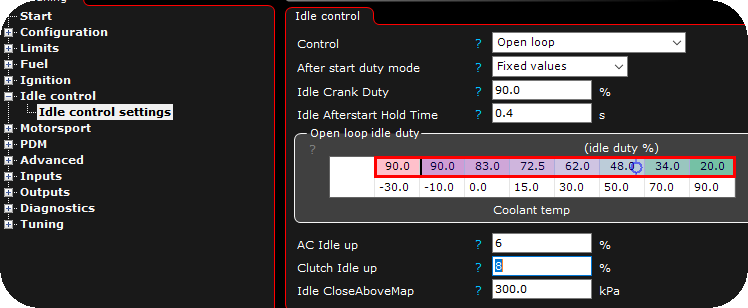
2. Change the open loop idle duty to suit your need, watch the RealTime Data value Idle control --> Idle ctrl duty air.
Note: Some PWM solenoids do require a flyback diode to be mounted (mostly if a very small duty change does change the air amount rapidly) (hard to control air flow).
Closed loop idle control using E-Throttle control
1. We assume your E-Throttle settings are up and running, and all PID settings are adjusted and works perfectly :)

2. In E-Throttle --> Throttle control, idle control, set the min and max throttle openings used by the idle control feature, in the above case 0% idle control = 2% throttle opening position, 100% idle control = 10% throttle opening position.
Note: if your normal idle throttle opening position is like 8%, do not set the above min value to 2% or similar, it is good to have the min value right below the normal opening position.
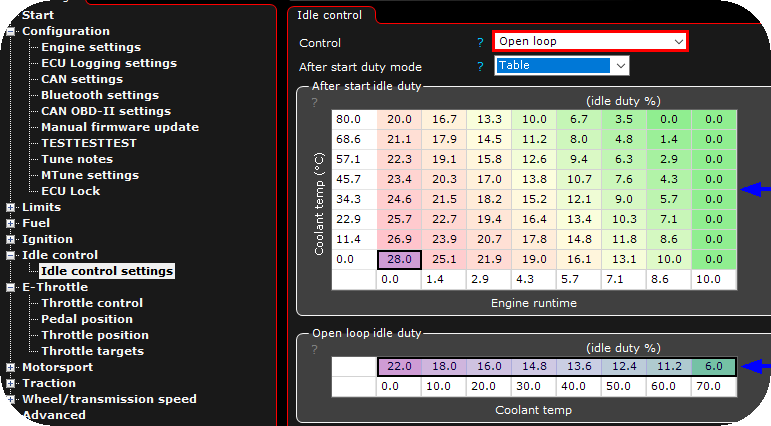
3. Tune in the open loop idle duty table first so that it you come close to your upcoming idle target. When satisfied, adjust the after start idle duty table to suit your need.

4. Change the control from open loop to Closed loop, single mode.
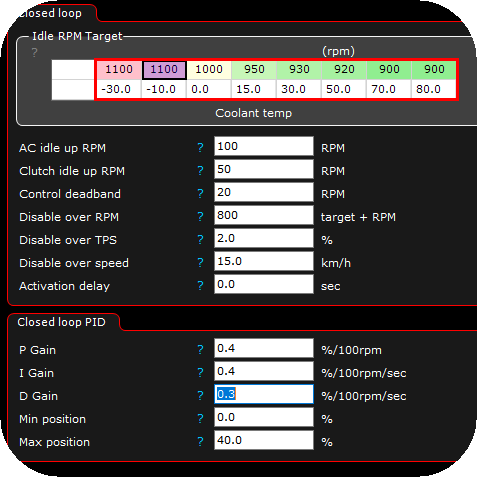
5. Update the Idle rpm target table with the desired idle rpm at different engine temperature.
Note: When using E-Throttle as idle control, the PID values are pretty low, cause big changes is not what you need, therefore the open loop base table tuning is the most important thing to do, do not skip.
Closed loop idle control using only ignition control
1. Let's assume your target idle is around 1000rpm, adjust the throttle stop to have like 1100-1200rpm on idle with cold engine and no ignition idle control activated when adjusting.

2. Activate the Ignition idle control function in Ignition --> Ignition lock/idle control. Enter the ignition advance control area suitable for your engine, in the above example the control area for idle ignition control is 4 to 36 deg ignition advance on idle. 0% idle control = 4 deg ignition advance, 100% idle control = 36 deg ignition advance.
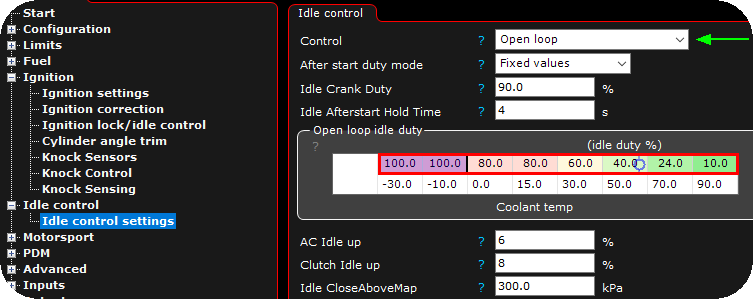
3. Firstly, adjust the open loop idle duty values before activation of the closed loop control. When satisfied with the open loop control, you are ready to move over to closed loop control in the next step (change Control method to Closed loop, single mode (air or ignition)).
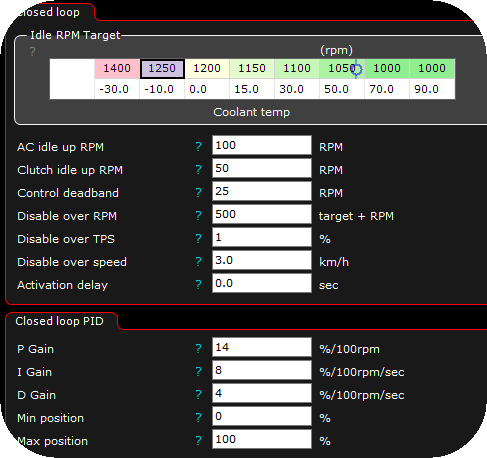
4. Example of closed loop settings for ignition idle control. In the above example, MaxxECU will try to achieve ~1050rpm (currently) by adjusting ignition advance on idle between 4 and 36 degrees BTDC.
Closed loop, dual mode with idle ignition and E-Throttle control
Note: E-Throttle settings needs to be perfectly adjusted and calibrated, see E-Throttle chapter for more information and howto setup.

1. Activate ignition idle control with relevant settings. In this example idle ignition control can change the ignition advance from -4 to 35 deg BTDC.

2. Enable the E-Throttle idle control feature.

3. In E-Throttle settings --> Throttle control, idle control, set the min and max throttle openings used by the idle control feature, in the above case 0% air idle control = 7% throttle opening position, 100% air idle control = 22% throttle opening position.

4. As always, always tune the open loop table first to get you close to your target.

5. Make sure the idle Control is set to Closed loop, dual mode (air AND ignition).
Note: When this mode is enabled, the closed loop PID is now controlling the Ignition.
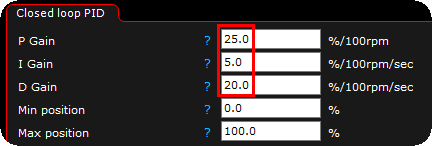
6. When the Closed loop, dual mode (air AND ignition) mode is selected, the main closed loop PID is now controlling ignition advance.

7. Enable the Secondary Air PID control, which will have it's own PI for the air flow control (using E-Throttle).
When all conditions are met for the closed loop idle ignition control, MaxxECU firstly try to adjust the ignition to come close to the idle rpm target value, and then slowly add/remove air (RealTime Data value: Idle ctrl duty air) while adjusting the ignition advance (RealTime Data value: idle ctrl duty ign) to bring it to its 50% target.